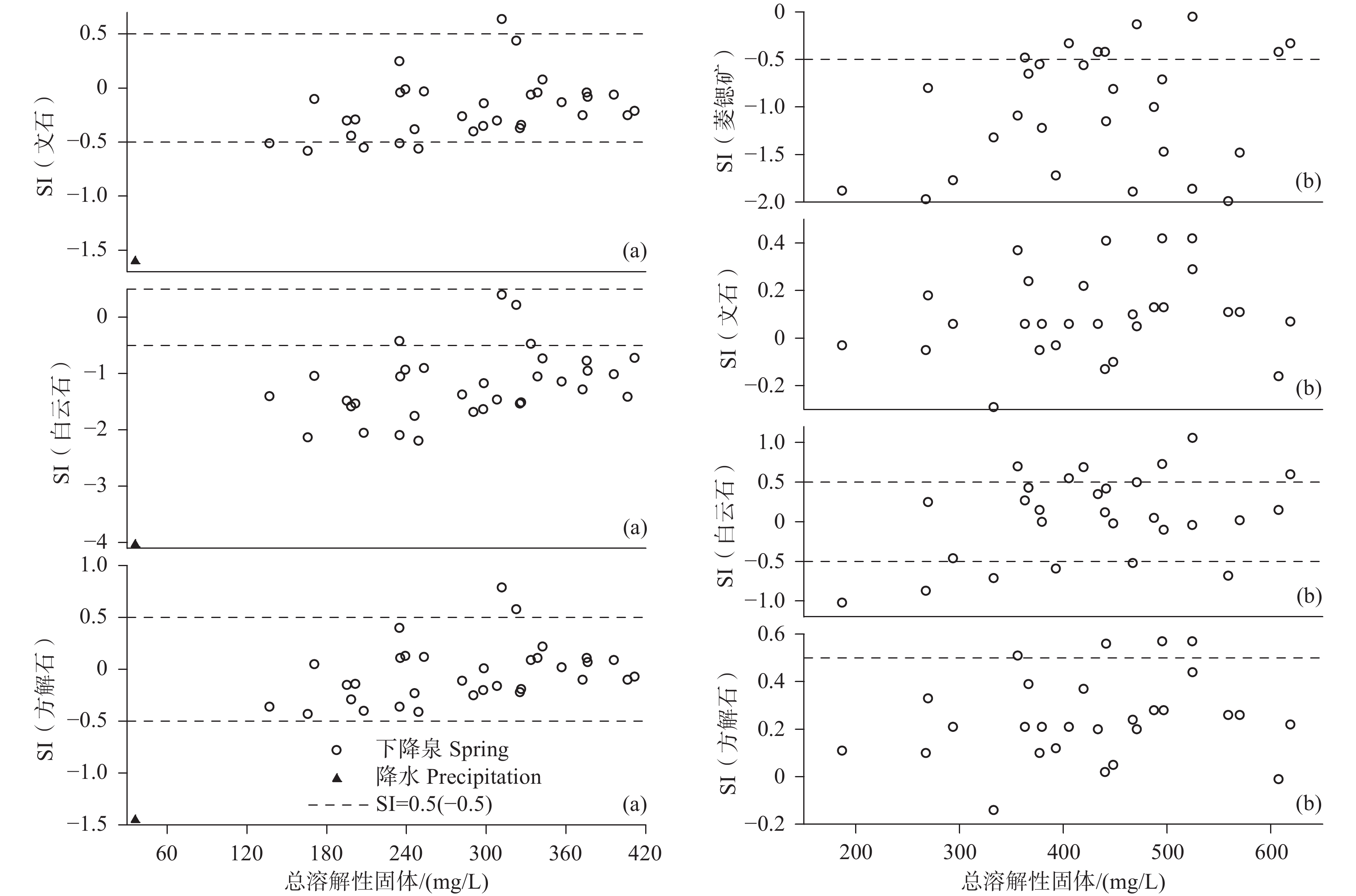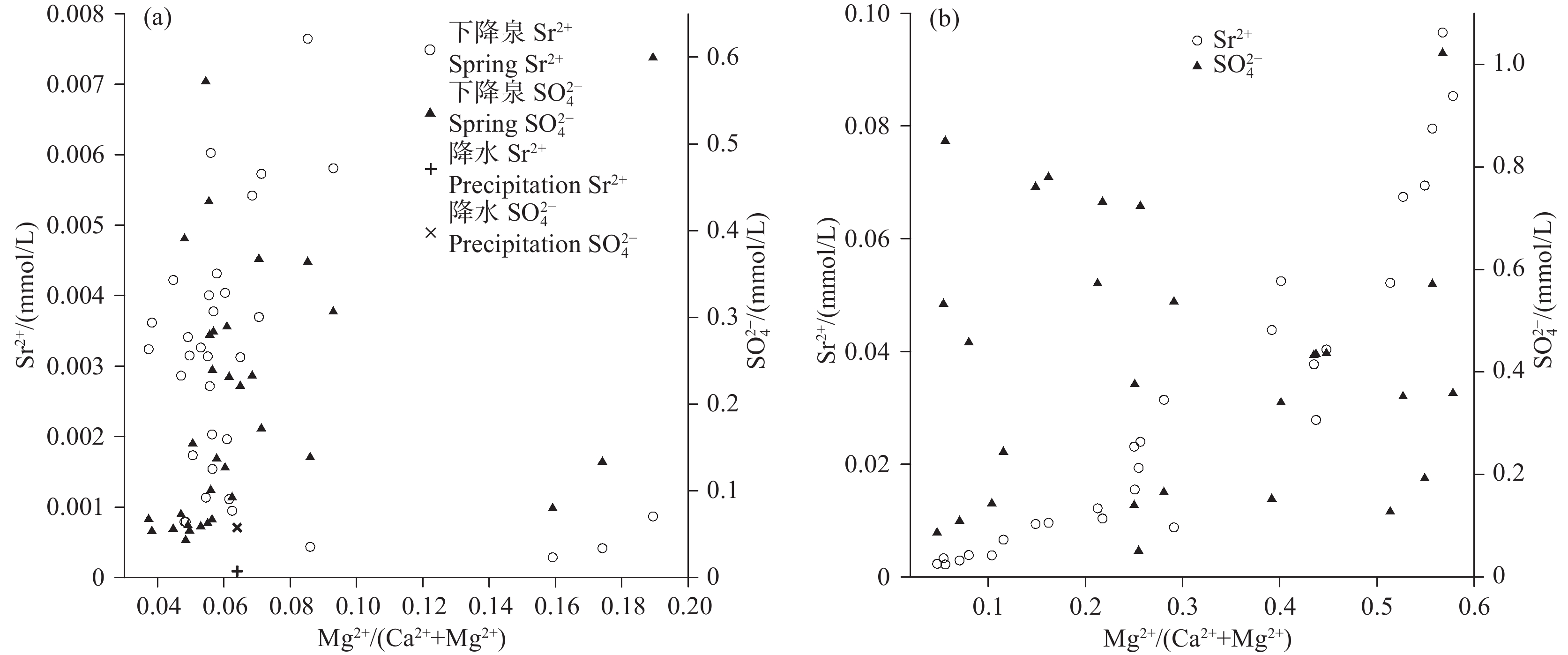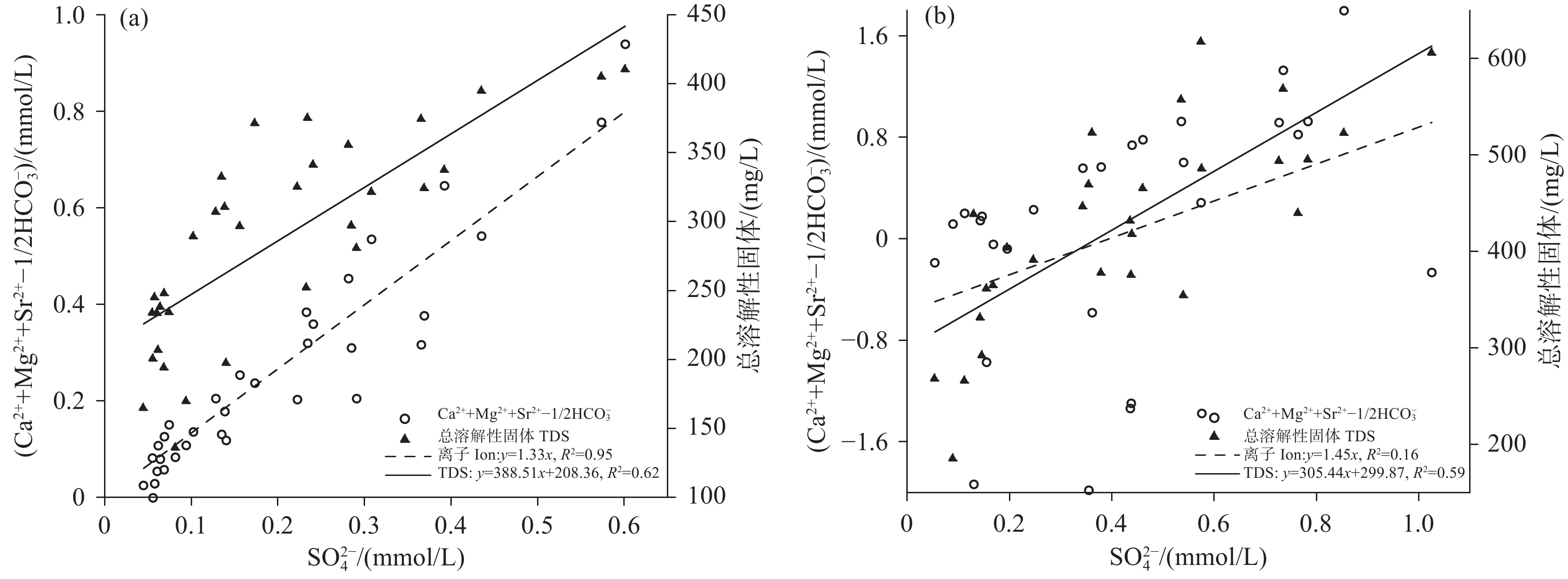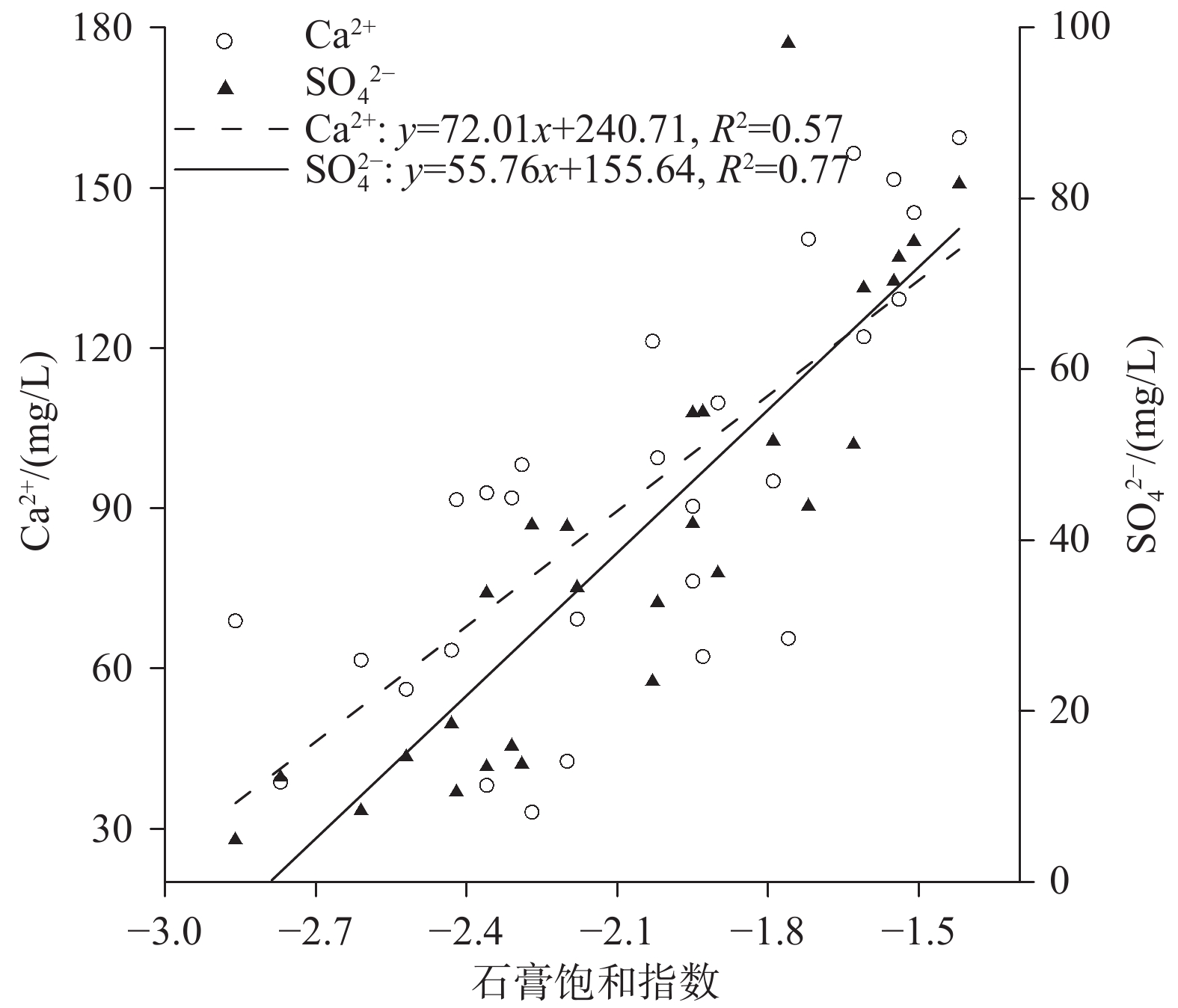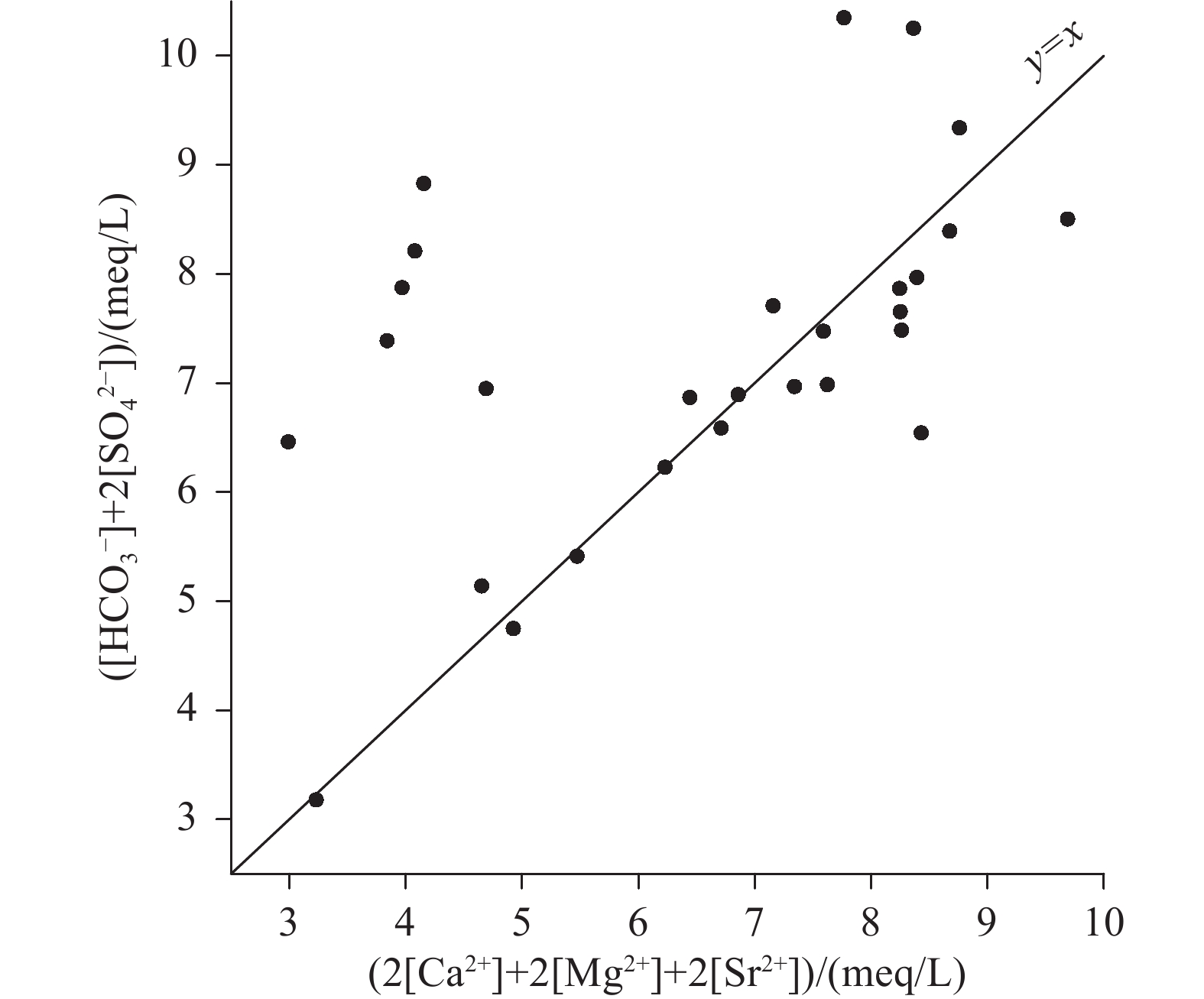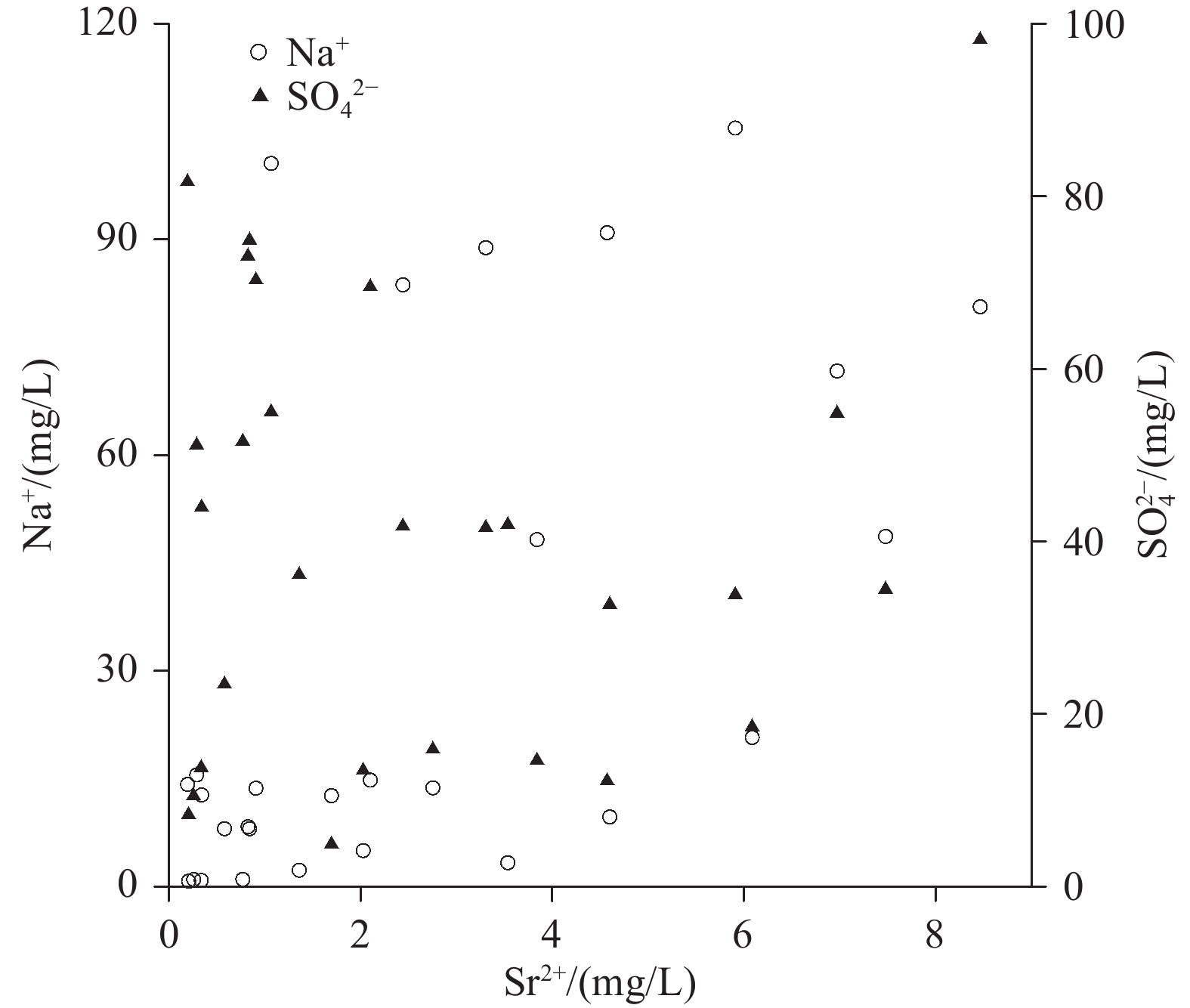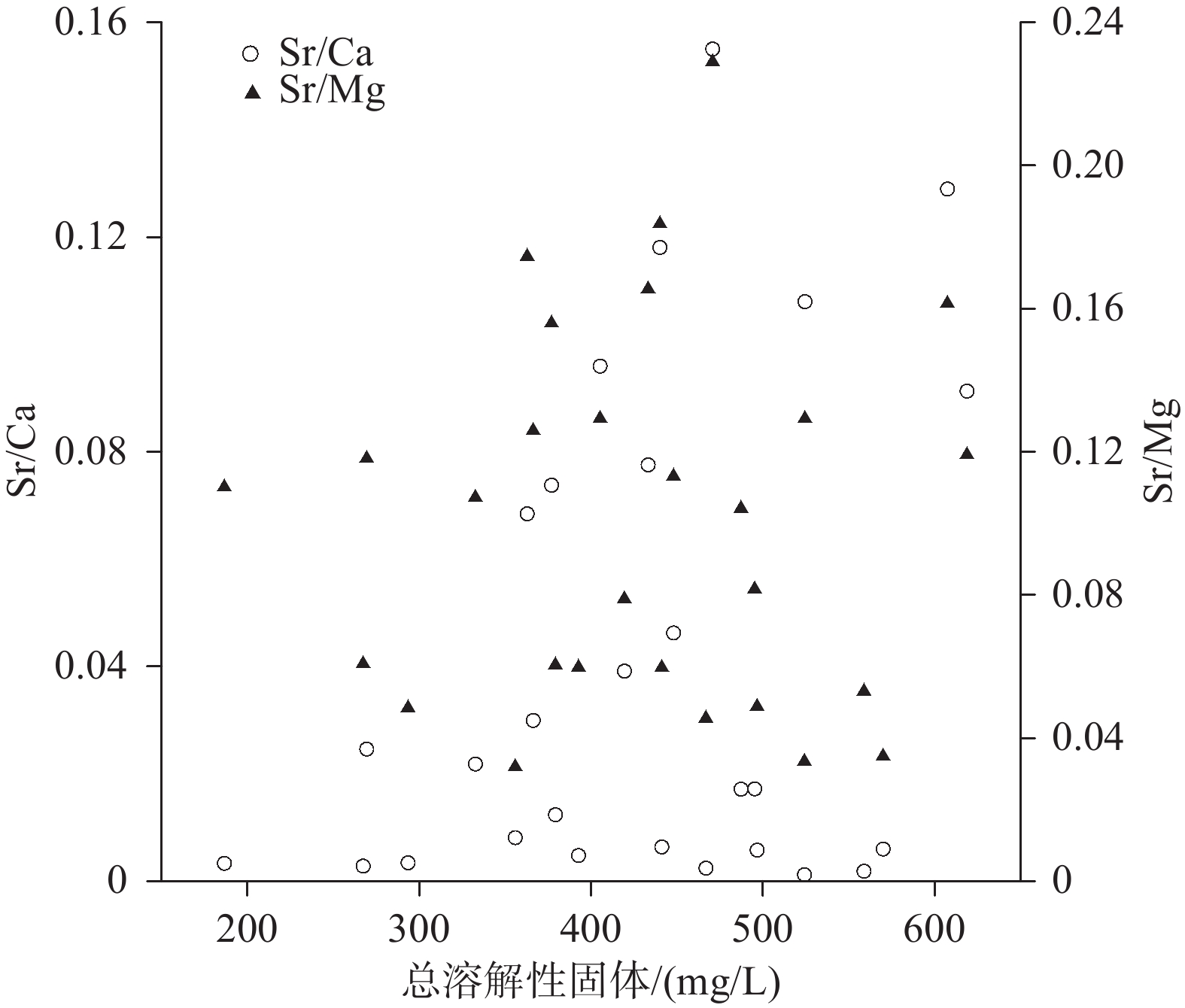Mineral saturation index characteristics, sources of Sr2+, SO42− and development potential of strontium−rich karst water in Xintian County, Hunan Province
-
摘要:
研究目的 湖南新田县发现大型富锶矿泉水田,然而锶元素来源及锶矿泉开发利用潜力研究相对薄弱,此外探究富锶岩溶水水化学特征及锶元素来源可为岩溶区寻找富锶地下水提供一定的理论支撑。
研究方法 通过开展水文地质调查,富锶地下水水化学指标检测分析,利用PHREEQC软件、水化学计量法、端元法、水文地质参数等揭示富锶岩溶水矿物饱和指数特征,Sr2+、SO42−来源及富锶地下水开发潜力。
研究结果 方解石在下降泉和机井中均主要处于饱和状态,白云石由下降泉中未饱和状态转为机井中的饱和状态,菱锶矿在机井中出现饱和状态,石膏在下降泉和机井中均为未饱和状态。下降泉中矿物饱和指数随泉水溶解性总固体增加而升高,两者呈较好的正相关关系,但在机井中两者相关性较差。下降泉SO42−和大气降水SO42−具有较好的拟合关系,根据Ca2+、Mg2+、Sr2+、HCO3−、SO42−化学计量关系,机井中SO42−可能来源于石膏溶解。下降泉中Sr2+主要来源于石灰岩中以类质同像置换钙的锶,机井中Sr2+较大可能来源于含水层中菱锶矿。研究区85.2%水点的地下水符合国家生活饮用水卫生标准,超标水点多为单指标超标。经计算,枯水年富锶地下水天然补给资源量、可开采资源量和地下水资源潜力分别为3.83×107 m3/a、1.05×107 m3/a、7.28×106 m3/a。
结论 新田县富锶地下水中锶主要来源于泥盆系佘田桥组地层含锶矿物(类质同像置换钙的锶和菱锶矿)的溶解,富锶地下水资源量及资源潜力可观,具有较大的开发利用潜力与价值。
Abstract:This paper is the result of hydrogeological survey engineering.
Objective There is limited research on the sources of strontium elementand the potential for the development and utilization of karst water in the large−scale strontium rich mineral water field in Xintian County, Hunan Province. Exploring the hydrochemical characteristics of strontium−rich karst water and the sources of strontium element can provide theoretical support for searching for strontium rich groundwater in karst areas.
Methods PHREEQC software, water stoichiometry, end element method and hydrogeological parameters were used in this study to reveal the mineral saturation index characteristicsof strontium−rich karst water, as well as the sources of Sr2+ and SO42− and its development potential through the hydrogeological investigation and hydrochemical testson groundwater in this strontium−rich mineral water field.
Results Calcite is mainly saturated both in the springs and shafts, while dolomite changes from unsaturated in the springs to saturate in the shafts. Strontium is saturated in the shafts, and gypsum is unsaturated both in the springs and the shafts. In the springs, mineral saturation index increases with the total dissolved solids, and they areof a good positive correlation, but of a poor correlation in the shafts. The correlation of SO42− betweenthe springs and shaftsare positive. According to the stoichiometric relation of Ca2+, Mg2+, Sr2+, HCO3− and SO42−, SO42− in the shafts may come from gypsum dissolution. The Sr2+ in the springsare mainly derived from strontium which replaces calcium with isomorphism in limestone, while Sr2+ in the shafts probably come from strontium siderite in the aquifer. 85.2% of the groundwatersamplings in the research area meet the national standard for drinking water quality, and the excess water samplings are mostly single indicator exceeding the standard. Through calculation, the natural recharge resources, exploitable resources and groundwater resource potential of strontium−rich groundwater in dry years are 3.83×107 m3/a、1.05×107 m3/a、7.28×106 m3/a respectively.
Conclusions Strontium in the strontium−rich groundwater in Xintian County is mainly derived from the dissolution of strontium−containing minerals in Shetianqiao Formation strata of Devonian. Those minerals, including strontianite, were form by isomorphicly substitute of calcium with strontium. The amount and resource potential of strontium−rich groundwater are considerable, with a great value for development and utilization.
-

-
图 1 湖南新田县富锶地下水采样点分布图(据夏日元等, 2017修改)
Figure 1.
表 1 湖南新田县大气降水、下降泉、机井水化学指标含量统计结果
Table 1. Statistics of hydrochemical indicator content in springs, shafts and precipitation
分类 统计量 pH Sr2+ K+ Na+ Ca2+ Mg2+ HCO3− SO42− Cl− TDS 下
降
泉最小值 6.76 0.03 0.07 0.37 39.38 1.73 132.50 4.29 1.40 136.91 最大值 7.81 0.67 16.44 15.68 131.14 13.41 398.43 57.71 27.45 411.50 平均值 7.13 0.26 1.69 3.39 94.31 4.27 277.41 19.19 6.10 286.00 标准差 0.27 0.16 2.94 4.14 22.76 2.66 62.59 14.55 6.12 74.65 机
井最小值 6.90 0.20 0.28 0.76 33.10 1.86 182.98 5.18 1.68 186.56 最大值 7.62 8.47 16.04 105.52 159.42 58.22 581.31 98.43 88.78 618.82 平均值 7.33 2.64 2.57 31.63 91.83 22.92 393.74 40.36 19.96 428.27 标准差 0.21 2.48 2.94 35.96 37.79 16.31 80.89 25.33 22.00 105.02 大气降水 7.53 0.00771 0.77 0.19 8.92 0.37 31.49 5.53 0.9 36.27 注:除pH外所有指标含量单位均为mg/L;大气降水样品数1组,下降泉样品数33组,机井样品数28组。 表 2 富锶地下水部分常规指标含量统计结果
Table 2. Statistics of some conventional indexes content in strontium−rich groundwater
指标 下降泉 机井 最大值 平均值 最小值 最大值 平均值 最小值 Al/(μg/L) 178 / − 670 / − Cu/(μg/L) 1.52 / − 8.66 / − Pb/(μg/L) 0.76 0.42 0.25 15 1.85 0.32 Zn/(μg/L) 15.8 / − 437 / − Cr/(μg/L) 10.4 5.41 1.47 8.99 6.19 2.36 Cd/(μg/L) 0.2 / − 0.4 / − Mn/(μg/L) 190 / − 571 / − As/(μg/L) 1.38 / − 5.03 / − Hg/(μg/L) 0.14 / − 1.87 / − Se/(μg/L) 1.98 / − 2.04 / − Fe/(mg/L) 0.27 / − 1.1 / − NO3−−N/(mg/L) 78.94 / − 64.46 / − CODMn/(mg/L) 2.51 / − 1.37 / − 注:“−”表示含量低于检测线;“/”表示无数据。 -
[1] Acheampong S Y, Hess J W. 1998. Hydrogeologic and hydrochemical framework of the shallow groundwater system in the southern Voltaian sedimentary basin, Ghana[J]. Hydrogeology Journal, (6): 527−537.
[2] Banner J L. 1995. Application of the trace element and isotope geochemistry of strontium to studies of carbonate diagenesis[J]. Sedimentology, 42(5): 805−824. doi: 10.1111/j.1365-3091.1995.tb00410.x
[3] Bao Zhenxin. 2010. Parameter Estimation on Curve–Fitting Methodology in Hydrologic Frequency Analysis[D]. Nanjing: Nanjing Hydraulic Research Institute, 1–81(in Chinese with English abstract).
[4] Cao Jianwen, Xia Riyuan, Tang Zhonghua, Zhao Liangjie, Wang Zhe, Luan Song, Wang Song. 2021. Groundwater resources in Guangdong–Hong Kong–Macao greater bay area and its development potential[J]. Geology in China, 48(4): 1075−1093 (in Chinese with English abstract).
[5] China Geological Survey. 2012. Handbook of Hydrogeology (Second Edition)[M]. Beijing: Geological Publishing House, 686–694(in Chinese).
[6] Fan Wei, Yang Yuesuo, Ye Xueyan, Lu Ying. 2010. Hydrogeochemical and environmental characteristics of strontium–enrichment in groundwater and its genesis in Qingken lake area[J]. Journal of Jilin University (Earth Science Edition), 40(2): 349−355 (in Chinese with English abstract).
[7] Gao Xubo, Xiang Xuanli, Hou Baojun, Gao Liebo, Zhang Jianyou, Zhang Songtao, Li Chengcheng, Jiang Chunfang. 2020. Application of hydrochemistry coupled with stable isotopes in the study of karst water hydrogeology[J]. Carsologica Sinica, 39(5): 629−636 (in Chinese with English abstract).
[8] Guo Qinghai, Wang Yanxin. 2006. Hydrogeochemistry as an indicator for karst groundwater flow: A case study in the Shentou karst water system, Shanxi, China[J]. Geological Science and Technology Information, 25(3): 85−88 (in Chinese with English abstract).
[9] Huang Q B, Qin X Q, Yang Q Y, Liu P Y, Zhang J S. 2016. Identification of dissolved sulfate sources and the role of sulfuric acid in carbonate weathering using δ13CDIC and δ34S in karst area, northern China[J]. Environmental Earth Sciences, 75(1): 51. doi: 10.1007/s12665-015-4869-6
[10] Huang Qibo, Kang Zhiqiang, Qin Xiaoqun, Yu Jianguo, Su Chuntian. 2011. Distribution characteristics of Sr2+, Sr/Mg, Sr/Ca and its applications in karst water system of Xishui County[J]. Geological Science and Technology Information, 30(4): 98−103 (in Chinese with English abstract).
[11] Huang Qibo, Qin Xiaoqun, Liu Pengyu, Tang Pingping. 2014. The characteristics and influencing factors of SO42– and sulfate isotope (δ34S) in different types of groundwater in Fenyang, Shanxi Province[J]. Quaternary Sciences, 34(2): 364−371 (in Chinese with English abstract).
[12] Huang Qibo. 2019. The Carbon Sequestration Effect in Semi–Arid Karst Area: A Case Study of Liuling Spring Catchment, Shanxi Province[D]. Wuhan: China University of Geosciences, 1−130 (in Chinese with English abstract).
[13] Jiang Zhongcheng, Xia Riyuan, Shi Jian, Pei Jianguo, He Shiyi, Liang Bin. 2006. The application effects and exploitation capacity of karst underground water resources in Southwest China[J]. Acta Geoscientica Sinica, 27(5): 495−502 (in Chinese with English abstract).
[14] Li Yilian, Wang Yanxin, Zhang Jianghua, Gao Hongbo. 2000. Geochemical modeling of sulfate pollution in karst water of Niangziguan region, Shanxi Province, China[J]. Earth Science—Journal of China University of Geosciences, 25(5): 467−471 (in Chinese with English abstract).
[15] Li Yilian, Wang Yanxin, Zhou Lairu, Gao Hongbo, Zhang Jianghua. 2002. Hydrogeochemical modeling on saturation of minerals in groundwater: A case study at Niangziguang, northern China[J]. Geological Science and Technology Information, 21(1): 32−36 (in Chinese with English abstract).
[16] Liu Congqiang. 2007. Biogeochemical Processes and Cycling of the Nutrients in the Earth’s Surface–Chemical Erosion and Nutrient Cycling in Karstic Catchment, Southwest China[M]. Beijing: Science Press, 311–314(in Chinese).
[17] Liu C Q, Lang Y C, Satake H, Wu J H, Li S L. 2008. Identification of anthropogenic and natural inputs of sulfate and chloride into the karstic ground water of Guiyang, SW China: Combined δ37Cl and δ34S approach[J]. Environmental Science & Technology, 42(15): 5421−5427.
[18] Liu Qingxuan, Wang Guiling, Zhang Fawang. 2004. Geochemical environment of trace element strontium (Sr) enriched in mineral waters[J]. Hydrogeology & Engineering Geology, 31(6): 19−23 (in Chinese with English abstract).
[19] Ma Zhiyuan, Fan Jijiao. 2005. Sulfate forming from groundwater in eastern Weibei karst area, Shanxi Province[J]. Coal Geology & Exploration, 33(3): 45−48 (in Chinese with English abstract).
[20] Nai Weihua, Wang Wenke, Wang Yixing, Duan Lei, Shi Jie, Li Bin. 2018. Sulfate distribution and source of groundwater from Kashgar plain[J]. Xinjiang Geology, 36(1): 120−123 (in Chinese with English abstract).
[21] Odum H T. 1957. Strontium in natural waters[J]. Publications of the Institute of Marine Science, University of Texas, 4(2): 22–37.
[22] Plummer L N, Busby J F, Lee R W, Hanshaw B B. 1990. Geochemical modeling of the Madison aquifer in parts of Montana, Wyoming, and South Dokata[J]. Water Resource Research, 26(9): 1981−2014. doi: 10.1029/WR026i009p01981
[23] Qian Hui, Ma Zhiyuan, Li Peiyue. 2012. Hydrogeochemistry (Second Edition)[M]. Beijing: Geological Publishing House, 47–48(in Chinese).
[24] Ren Kun, Pan Xiaodong, Lan Ganjiang, Peng Cong, Liang Jiapeng, Zeng Jie. 2021. Seasonal variation and sources identification of dissolved sulfate in a typical karst subterranean stream basin using sulfur and oxygen isotopes[J]. Environmental Science, 42(9): 4267−4274 (in Chinese with English abstract).
[25] Shawan S D, Andrew L H. 2002. Strontium and carbon isotope constraints on carbonate–solution interactions and inter–aquifer mixing in groundwaters of the semi–arid Murray Basin, Australia[J]. Journal of Hydrology, 262: 50−67. doi: 10.1016/S0022-1694(02)00021-5
[26] Shen Zhaoli, Zhu Wanhua, Zhong Zuoshen. 1993. Fundamentals of Hydrogeochemistry[M]. Beijing: Geological Publishing House, 96–97(in Chinese).
[27] Siegel D I, Bickford M E, Orrell S E. 2000. The use of strontium and lead isotopes to identify sources of water beneath the Fresh Kills landfill, Staten Island, New York, USA[J]. Applied Geochemistry, 15(4): 493−500. doi: 10.1016/S0883-2927(99)00063-3
[28] Su Chuntian, Huang Chenhui, Zou Shengzhang, Xie Daixing, Zhao Guangshuai, Tang Jiansheng, Luo Fei, Yang Yang. 2017a. Enrichment environment and sources of strontium of groundwater in Xintian county, Hunan Province[J]. Carsologica Sinica, 36(5): 678−683 (in Chinese with English abstract).
[29] Su Chuntian, Zhang Fawang, Xia Riyuan, Yao Xin, Zou Shengzhang, Luo Fei, Zhao Guangshuai, Yang Yang, Ba Junjie, Li Xiaopan. 2017b. A study of the water–rock interaction of large rich Sr mineral spring in Xintian, Hunan Province[J]. Geology in China, 44(5): 1029−1030 (in Chinese with English abstract).
[30] Su Chuntian, Tang Jiansheng, Luo Fei, Li Zhaolin. 2020. Investigation and Study on Groundwater in Xintian River Karst Basin, Hunan Province[M]. Wuhan: China University of Geosciences Press, 131–153(in Chinese).
[31] Wang Yanxin, Sun Lianfa, Luo Chaohui, Gao Hongbo, Sun Zhihong. 1997. The analyse of hydrochemical and istopic information indicating the dynamic environment of Niangziguan springs[J]. Hydrogeology & Engineering Geology, 24(3): 1−5 (in Chinese with English abstract).
[32] Wang Yu. 2020. Evaluation status and problems of groundwater resource potential in Yunnan Province[J]. Carsologica Sinica, 39(2): 137−146 (in Chinese with English abstract).
[33] Wang Zengyin, Liu Juan, Cui Yinxiang, Wang Tao, Guo Tianyuan. 2003. Distribution characteristics of Sr/Mg、Sr/Ca and applications in Yanhe spring karst water system[J]. Hydrogeology & Engineering Geology, 30(2): 15−19 (in Chinese with English abstract).
[34] Xia Riyuan, Jiang Zhongcheng, Zou Shengzhang, Cao Jianhua, Qin Xiaoqun, Su Chuntian, Luo Weiqun, Zhou Lixin. 2017. Progress of hydrogeology and environmental geology comprehensive survey in karst area[J]. Geological Survey of China, 4(1): 1−10 (in Chinese with English abstract).
[35] Xia Riyuan, Lu Haiping, Cao Jianwen, Zhao Liangjie, Wang Zhe, Luan Song. 2022. Characteristics of groundwater resources of karst areas in the Southern China and water resources guarantee countermeasures[J]. Geology in China, 49(4): 1139−1153 (in Chinese with English abstract).
[36] Ye Ping, Zhou Aiguo, Liu Cunfu, Wu Jinbo. 2007. New water–rock interaction evidence for groundwater in the Hebei plain: Characteristics of Sr isotope tracer[J]. Hydrogeology & Engineering Geology, 34(4): 41−43 (in Chinese with English abstract).
[37] Zhang Jianghua, Liang Yongping, Wang Weitai, Han Xingrui, Hou Guangcai. 2009. A practical use of 34S in the investigation of karst groundwater resource in North China[J]. Carsologica Sinica, 28(3): 235−241 (in Chinese with English abstract).
[38] Zhao Guangshuai, Su Chuntian, Pan Xiaodong, Xie Daixing, Luo Fei, Yang Yang, Ba Junjie, Li Xiaopan, Bi Benteng. 2019. Hydrogeochemical zoning characteristics of the strontium mineral spring in Xintian county, Hunan Province[J]. Carsologica Sinica, 38(6): 858−866 (in Chinese with English abstract).
[39] Zhao Liangjie, Wang Ying, Zhou Yan, Cao Jianwen, Yang Yang, Wang Zhe. 2022. Groundwater resources evaluation in the Pearl River basin based on SWAT model[J/OL]. Earth Science, 1−19. https://kns.cnki.net/kcms/detail/42.1874.P.20220119.1634.006.html(in Chinese with English abstract).
[40] 鲍振鑫. 2010. 水文频率分析适线法参数估计研究[D]. 南京: 南京水利科学研究院, 1–81.
[41] 曹建文, 夏日元, 唐仲华, 赵良杰, 王喆, 栾松, 王松. 2021. 粤港澳大湾区地下水资源特征及开发潜力[J]. 中国地质, 48(4): 1075−1093. doi: 10.12029/gc20210407
[42] 范伟, 杨悦锁, 冶雪艳, 路莹. 2010. 青肯泡地区地下水中锶富集的水文地球化学环境特征及成因分析[J]. 吉林大学学报(地球科学版), 40(2): 349−355.
[43] 高旭波, 向绚丽, 侯保俊, 高列波, 张建友, 张松涛, 李成城, 姜春芳. 2020. 水化学–稳定同位素技术在岩溶水文地质研究中的应用[J]. 中国岩溶, 39(5): 629−636. doi: 10.11932/karst2020y26
[44] 郭清海, 王焰新. 2006. 水文地球化学信息对岩溶地下水流动系统特征的指示意义—以山西神头泉域为例[J]. 地质科技情报, 25(3): 85−88.
[45] 黄奇波, 康志强, 覃小群, 俞建国, 苏春田. 2011. 习水县岩溶水系统ρ(Sr2+)、ρ(Sr)/ρ(Ca)、ρ(Sr)/ρ(Mg)分布特征及其应用[J]. 地质科技情报, 30(4): 98−103.
[46] 黄奇波, 覃小群, 刘朋雨, 唐萍苹. 2014. 汾阳地区不同类型地下水SO42–、δ34S的特征及影响因素[J]. 第四纪研究, 34(2): 364−371. doi: 10.3969/j.issn.1001-7410.2014.02.10
[47] 黄奇波. 2019. 北方半干旱岩溶区岩溶碳汇过程及效应研究—以山西柳林泉岩溶流域为例[D]. 武汉: 中国地质大学, 1−130.
[48] 蒋忠诚, 夏日元, 时坚, 裴建国, 何师意, 梁彬. 2006. 西南岩溶地下水资源开发利用效应与潜力分析[J]. 地球学报, 27(5): 495−502. doi: 10.3321/j.issn:1006-3021.2006.05.012
[49] 李义连, 王焰新, 张江华, 高红波. 2000. 娘子关泉域岩溶水硫酸盐污染的地球化学模拟分析[J]. 地球科学—中国地质大学学报, 25(5): 467−471.
[50] 李义连, 王焰新, 周来茹, 高红波, 张江华. 2002. 地下水矿物饱和度的水文地球化学模拟分析—以娘子关泉域岩溶水为例[J]. 地质科技情报, 21(1): 32−36.
[51] 刘丛强. 2007. 生物地球化学过程与地表物质循环—西南喀斯特流域侵蚀与生源要素循环[M]. 北京: 科学出版社, 311–314.
[52] 刘庆宣, 王贵玲, 张发旺. 2004. 矿泉水中微量元素锶富集的地球化学环境[J]. 水文地质工程地质, 31(6): 19−23. doi: 10.3969/j.issn.1000-3665.2004.06.004
[53] 马致远, 范基姣. 2005. 陕西渭北东部岩溶地下水中硫酸盐的形成[J]. 煤田地质与勘探, 33(3): 45−48. doi: 10.3969/j.issn.1001-1986.2005.03.014
[54] 乃尉华, 王文科, 王艺星, 段磊, 史杰, 李斌. 2018. 喀什平原区地下水硫酸盐分布特征及来源[J]. 新疆地质, 36(1): 120−123. doi: 10.3969/j.issn.1000-8845.2018.01.019
[55] 钱会, 马致远, 李培月. 2012. 水文地球化学(第二版) [M]. 北京: 地质出版社, 47–48.
[56] 任坤, 潘晓东, 兰干江, 彭聪, 梁嘉鹏, 曾杰. 2021. 硫氧同位素解析典型岩溶地下河流域硫酸盐季节变化特征和来源[J]. 环境科学, 42(9): 4267−4274.
[57] 沈照理, 朱宛华, 钟佐燊. 1993. 水文地球化学基础[M]. 北京: 地质出版社, 96–97.
[58] 苏春田, 黄晨晖, 邹胜章, 谢代兴, 赵光帅, 唐建生, 罗飞, 杨杨. 2017a. 新田县地下水锶富集环境及来源分析[J]. 中国岩溶, 36(5): 678−683.
[59] 苏春田, 张发旺, 夏日元, 姚昕, 邹胜章, 罗飞, 赵光帅, 杨杨, 巴俊杰, 李小盼. 2017b. 湖南新田发现大型富锶矿泉水及机理研究[J]. 中国地质, 44(5): 1029−1030. doi: 10.12029/gc20170515
[60] 苏春田, 唐建生, 罗飞, 李兆林. 2020. 湖南新田河岩溶流域地下水调查研究[M]. 武汉: 中国地质大学出版社, 131–153.
[61] 王焰新, 孙连发, 罗朝晖, 高红波, 孙志鸿. 1997. 指示娘子关泉群水动力环境的水化学–同位素信息分析[J]. 水文地质工程地质, 24(3): 1−5.
[62] 王宇. 2020. 云南省地下水资源潜力评价现状与问题分析[J]. 中国岩溶, 39(2): 137−146. doi: 10.11932/karst20200201
[63] 王增银, 刘娟, 崔银祥, 王涛, 郭天元. 2003. 延河泉岩溶水系统Sr/Mg、Sr/Ca分布特征及其应用[J]. 水文地质工程地质, 30(2): 15−19. doi: 10.3969/j.issn.1000-3665.2003.02.004
[64] 夏日元, 蒋忠诚, 邹胜章, 曹建华, 覃小群, 苏春田, 罗为群, 周立新. 2017. 岩溶地区水文地质环境地质综合调查工程进展[J]. 中国地质调查, 4(1): 1−10.
[65] 夏日元, 卢海平, 曹建文, 赵良杰, 王喆, 栾崧. 2022. 南方岩溶区地下水资源特征与水资源保障对策[J]. 中国地质, 49(4): 1139−1153. doi: 10.12029/gc20220408
[66] 叶萍, 周爱国, 刘存富, 武金博. 2007. 河北平原地下水水––岩作用新证据—锶同位素示踪演变特征[J]. 水文地质工程地质, 34(4): 41−43. doi: 10.3969/j.issn.1000-3665.2007.04.011
[67] 张江华, 梁永平, 王维泰, 韩行瑞, 候光才. 2009. 硫同位素技术在北方岩溶水资源调查中的应用实例[J]. 中国岩溶, 28(3): 235−241. doi: 10.3969/j.issn.1001-4810.2009.03.002
[68] 赵光帅, 苏春田, 潘晓东, 谢代兴, 罗飞, 杨杨, 巴俊杰, 李小盼, 毕奔腾. 2019. 湖南新田锶矿泉水文地球化学分带特征分析[J]. 中国岩溶, 38(6): 858−866. doi: 10.11932/karst20190603
[69] 赵良杰, 王莹, 周妍, 曹建文, 杨杨, 王喆. 2022. 基于SWAT模型的珠江流域地下水资源评价研究[J/OL]. 地球科学, 1−19. https://kns.cnki.net/kcms/detail/42.1874.P.20220119.1634.006.html
[70] 中国地质调查局. 2012. 水文地质手册[M]. 第二版, 北京: 地质出版社, 686–694.
-



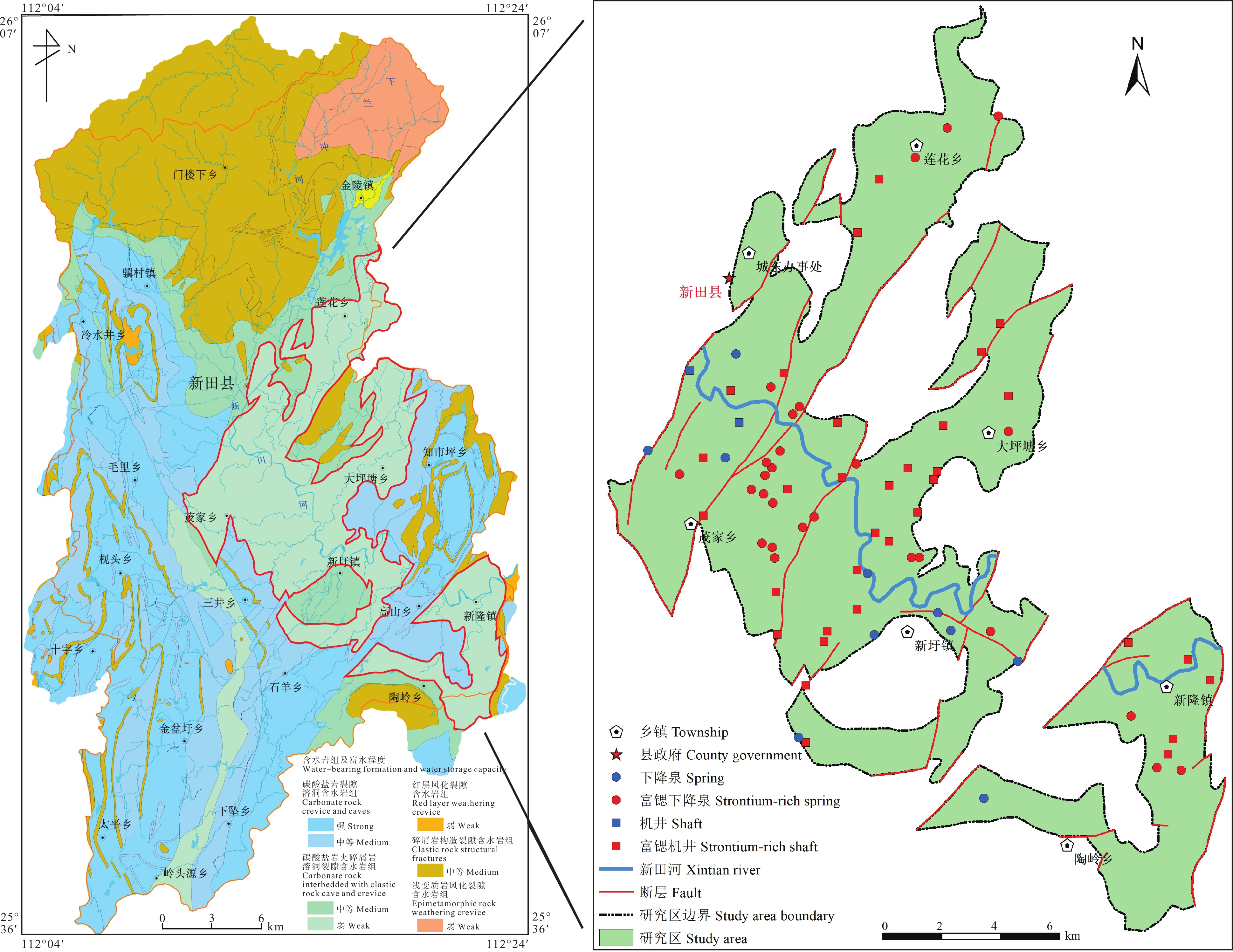
 下载:
下载:

